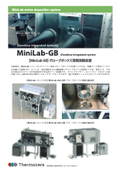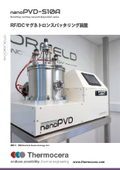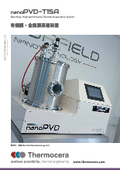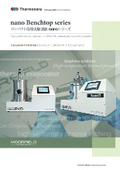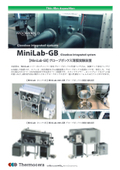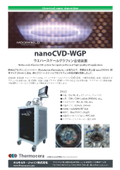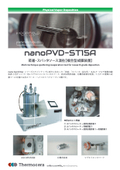□■□【MiniLab-080】Flexible Thin Film Experiment Device□■□
Flexible configuration available upon request for processes such as evaporation, sputtering, and EB. Adopts a tall chamber with a height of 570mm, contributing to improved uniformity during evaporation.
The ML-080, composed of a D-type box chamber with a volume of 80 liters and dimensions of 400(W)x400(D)x570(H)mm, features a higher chamber compared to the 060 model, resulting in a longer TS distance adjustment range and improved film uniformity during deposition on large-diameter substrates. It is an optimal model for vacuum deposition and is a higher-end version of the ML-060, which can also accommodate a load lock mechanism. Like the 060, it is compact yet supports a wide range of applications including resistance heating deposition (for metals, insulators, and organic materials), EB deposition, RF/DC/Pulse DC compatible magnetron sputtering, RIE plasma etching, and annealing. - Maximum substrate size: Φ10 inch - Resistance heating deposition sources: up to 4 sources - Organic deposition sources: up to 4 sources - Magnetron sputtering cathodes: 4 sources - Electron beam deposition - Substrate heating stage (standard 500℃, max 1000℃) - *Plasma etching / <30W soft etching *Plasma etching can be installed in both the main chamber and the load lock chamber.
basic information
【Main Specifications】 - SUS304 80ℓ volume 400x400x570mm front-loading chamber - Pump: Turbo molecular pump, rotary pump (dry pump also available) - Vacuum exhaust: Automatic control of vacuum/vent - Resistance heating deposition: Up to 4 source points (Model TE1 to TE4 deposition sources) - Organic deposition: Up to 4 sources (Model LTEC-1cc/5cc) - EB electron beam deposition source: 7cc crucible x 6 (or 4cc crucible x 8) - Φ2 to 4 inch magnetron sputtering cathode x up to 4 sources - Process control: Manual or automatic multilayer continuous film deposition/multiple simultaneous film deposition, APC automatic control - Film thickness monitor: Quartz crystal oscillator sensor head x 4 - Film thickness control: Inficon SQM-160 (or SQC-310) multi-channel film deposition controller - Utilities: Power supply 200V three-phase 15A, water cooling 3ℓ/min, N2 vent 0.1Mkpa - Other options: Substrate heating, cooling, substrate elevation/rotation, dry etching, dry scroll pump, load lock mechanism
Price information
This device is a customized product and will vary depending on the configuration, so please contact us for inquiries.
Delivery Time
Model number/Brand name
MiniLab-080
Applications/Examples of results
Various basic experimental applications in university and corporate research laboratories - Optical thin films - Electrode films, semiconductor films, wiring films, insulating films Others
Related Videos
catalog(37)
Download All Catalogs
News about this product(60)
-

◇◆◇ nanoPVD-S10A Magnetron Sputtering Device ◇◆◇
This is a research and development RF/DC magnetron sputtering device. Despite its high performance and multifunctionality, it fits into limited laboratory space with a compact size and easy operation via a 7-inch front touch panel. ● Achievable pressure: 5x10^-5 Pa (*fastest 30 minutes to 1x10^-4 Pa!) ● Film uniformity: ±3% ● Various options: up/down rotation, heater, cathode for magnetic materials, and more ● 3-source cathode + 3 MFC systems, with additional RF/DC power supply, allowing for versatile applications such as multilayer films and simultaneous deposition. - Insulating films - Conductive films - Compounds, etc. 【Main Features】 ◉ Compatible substrates: 2" (up to 3 sources) or 1" (1 source) ◉ 2" cathode x up to 3 sources ◉ Easy operation via touch panel with PLC automatic program control ◉ High-precision APC process control with MFC ◉ Up to 3 MFC systems ◉ USB port for Windows PC connection, capable of creating and saving recipes for up to 1000 layers and 50 films. Live data logging on PC. ◉ Vacuum system: TMP + RP (*dry pump option) ◉ Substrate rotation, vertical lift, and heating (Max 500℃) ◉ Quartz crystal film thickness monitor/controller
-

Wafer Annealing Equipment [ANNEAL] Max 1000℃ APC Automatic Pressure Control MFC x3 System Compatible with Φ4 to 6 inch Substrates
Max 1000℃, MFC up to 3 systems, APC pressure control, compatible with substrates from 4" to a maximum of 6", high vacuum annealing device (<5 × 10-7 mbar) [ANNEAL] is a research and development annealing device capable of high-temperature heat treatment of substrates such as wafers in a stable process atmosphere. It allows high-temperature processing up to 1000℃ using a heating stage installed in a high vacuum water-cooled SUS chamber. A heat shield is installed inside the chamber to ensure safety through interlock. The mass flow controller can be expanded to a maximum of 3 systems, enabling firing operations with precisely adjusted process gas pressure (APC automatic process control system option). Additionally, there are many options available, including a front view port, dry scroll pump, special substrate holder, and additional thermocouples. The heating stage inside the chamber has three variations depending on the process gas atmosphere and treatment temperature: - Halogen lamp heater: Max 500℃ - C/C composite heater: Max 1000℃ (in vacuum, inert gas only) - SiC coating heater: Max 1000℃ (vacuum, inert gas, O2)
-

☆★☆【nanoETCH】Soft Etching Device☆★☆
<30W Low Power Control for Damage-Free Etching Achieves delicate etching processes with an output control precision of 10mW. A jointly developed product with the graphene research group at the University of Manchester, led by Nobel Prize winners who discovered graphene in 2010. 【Features】 • 2D (Transition Metal Chalcogenides, graphene delamination after material transfer): Surface modification cleaning • Removal of polymer resists such as PMMA and PPA • Surface modification and etching on substrates prone to damage, such as Teflon substrates • h-BN sidewall etching (*Option for "Fluorine Gas Supply Module," requires SF6 gas system) • SiO2 etching (*Option for "Fluorine Gas Supply Module," requires CHF3 gas system) 【Specifications】 ◉ Compatible substrates: Up to Φ6 inches ◉ Easy operation with a 7" touch panel and PLC automatic sequencing ◉ Automatic pressure control (APC) ◉ One Ar gas line (standard) + up to three additional lines for N2 and O2 ◉ Connects to a Windows PC with a USB port for automatic etching recipe creation and storage. Data logging on PC.
-

◆◇◆【nanoCVD-8G】 Graphene Synthesis Device ◆◇◆
◉ High-efficiency and high-precision process control using cold wall method ◉ Rapid heating: 1100℃ in approximately 3 minutes ◉ High-precision temperature control: ±1℃ ◉ High-precision APC automatic pressure control system: 3 gas lines (Ar, H2, CH4) ◉ Standard recipe for graphene production included ◉ Compact size: 405(W) x 415(D) x 280(H) mm ◆Features◆ - Easy operation! Operation and recipe management via 5-inch touch panel - Up to 30 recipes and 30-step program creation possible - PC software included for USB cable connection, offline recipe creation on PC → upload/download to device, CSV data output - Maximum sample size: 40 x 40 mm: Copper (nickel) foil, SiO2/Si, Al2O3/Si substrates, etc. ◆Model: nanoCVD-8G◆ - Standard program for graphene included - High vacuum process, high-precision process pressure control - Rotary pump included as standard - 3 gas supply lines (Ar, H2, CH4) - Sample heating stage (high-purity graphite) Max 1100℃ - K-type thermocouple
-

◉Mini-BENCH-prism Semi-Automatic Ultra-High Temperature Experimental Furnace Max 2000℃
◉ Maximum operating temperature Max 2000℃ ◉ PLC semi-automatic control A higher model of the tabletop Mini-BENCH with semi-automatic control Automatically controls each process of "vacuum/purge cycle," "gas replacement," and "venting" Maximum operating temperature 2000℃ Semi-automatic control ultra-high temperature experimental furnace (carbon furnace, tungsten metal furnace) Compact and space-saving experimental furnace ◉ Effective heating range (crucible dimensions) - Planar heater heating range: Φ2 inch to Φ6 inch - Cylindrical heater heating range: Φ30 to Φ80 x Depth Max 100(H) mm ◉ Up to 3 MFC systems for automatic flow control (or manual adjustment) ◉ APC automatic pressure control ◉ Ensures safety during operation Monitors abnormal cooling water, chamber temperature, and overpressure. Made of SUS, the robust water-cooled chamber can be safely used even during continuous operation at maximum temperature. ◉ Compact and space-saving Width 603 x Depth 603 x Height 1,160 mm (*Installed inside rotary pump housing) Various sample heating experiments, such as ultra-high temperature heating of small samples and new material research and development, can be easily performed with simple operations. The main unit is compact yet can be used for research and development in various fields.
Recommended products
Distributors
【Endless possibility_thermal engineering...】 Our company sells vacuum thin film devices for semiconductor and electronic device fundamental research, ultra-high temperature heaters for CVD substrate heating, experimental furnaces, temperature measurement equipment, and more. To meet the endless demand for "heat," which is indispensable in any era, and to respond to various requests in the field of fundamental technology development, we aim to introduce the latest equipment and contribute to research and development in Japan.















